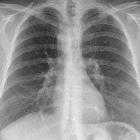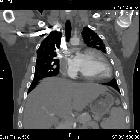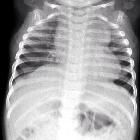right-sided aortic arch
















Right-sided aortic arch is a type of aortic arch variant characterized by the aortic arch coursing to the right of the trachea. Different configurations can be found based on the supra-aortic branching patterns, with the two most common patterns being the right-sided aortic arch with mirror image branching and the right-sided aortic arch with aberrant left subclavian artery (ALSA).
Epidemiology
A right-sided aortic arch is thought to occur in approximately ~0.1% (range 0.05-0.2%) of the population.
Clinical presentation
The majority of the patients are asymptomatic and it is discovered incidentally. However, it causes symptoms when associated with other vascular anomalies (vascular ring) due to compression on the esophagus and/or trachea.
Pathology
Classification
Right-sided arches can be divided into at least three types (please note that the numbering of the types varies from publication to publication and as such the abnormality should be described rather than merely numbered) .
- type I: right-sided aortic arch with mirror image branching
- sometimes reported as the most common, accounting for up to 59% of all right-sided arches . In most of the literature, it is less common than type II
- occurs from interruption of the dorsal segment of the left arch between the left subclavian artery and the descending aorta, with regression of the right ductus arteriosus in the hypothetical double aortic arch
- in this variant, the left brachiocephalic trunk arises first, followed by the right common carotid and right subclavian arteries
- usually associated with cyanotic congenital heart disease which includes
- type II: right-sided aortic arch with aberrant left subclavian artery
- common , at least accounting for 39.5% of all right-sided arches
- associated with a Kommerell diverticulum
- occurs from interruption of the dorsal segment of the left arch between the left common carotid and left subclavian arteries with regression of the right ductus arteriosus in the hypothetical double aortic arch
- in this variant, the left common carotid artery arises first, followed by the right common carotid, right subclavian, and then left subclavian arteries
- rarely produces symptoms and is usually incidental although can rarely cause esophageal and/or tracheal compression
- rarely associated with other cardiovascular abnormalities
- type III: right-sided aortic arch with isolation of the left subclavian artery
- most rare type: 0.8%
- results from interruption of the left arch at two levels, with one level between the left common carotid and left subclavian arteries and the other level distal to the attachment of the left ductus
- maybe associated with congenital subclavian steal syndrome and vertebrobasilar insufficiency
- can be rarely associated with congenital heart disease
Radiographic features
Plain radiograph
- left aortic contour is absent
- tracheal bowing to the left at the level of the right aortic arch
- soft tissue indentation on the right side of the distal trachea
- right-sided descending aorta
The right arch is often seen as high riding and projecting as a mass in the right paratracheal region .
CT/MRI
Cross-sectional imaging with CT or MRI allows direct visualization of arch anatomy and with dedicated angiographic techniques (MRA or CTA) excellent demonstration of the lumen can be achieved.
Siehe auch:
- Anomalien des Aortenbogens
- Herzfehler
- Fallot'sche Tetralogie
- tricuspid atresia
- Transposition der großen Arterien
- Subclavian-Steal-Syndrom
- Zyanotischer Herzfehler
- Truncus arteriosus communis
und weiter:
- Situs inversus
- CXR approach to congenital heart disease
- double outlet right ventricle (DORV)
- chest x-ray appeoach to congenital heart disease
- congenital heart disease - chest x-ray approach
- esophageal atresia with H-type tracheo-esophageal fistula
- Kommerell-Divertikel
- aberrierende linke Arteria subclavia
- H-type tracheo-oesophageal fistula with no atresia
- rechts descendierende Aorta mit aberrierender linker Arteria subclavia
- zirkumflexer retroösophagealer rechter Aortenbogen
- right aortic arch and agenesia of left pulmonary artery
- right sided aortic arch - fetal ultrasound
- angeborene ösophagotracheale Fistel
- vaskuläre Ringe

 Assoziationen und Differentialdiagnosen zu rechts descendierende Aorta:
Assoziationen und Differentialdiagnosen zu rechts descendierende Aorta:






